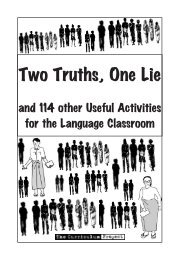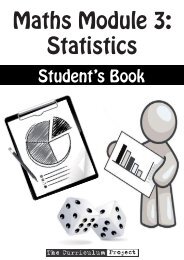Teacher's Guide - The Curriculum Project
Teacher's Guide - The Curriculum Project
Teacher's Guide - The Curriculum Project
- No tags were found...
Create successful ePaper yourself
Turn your PDF publications into a flip-book with our unique Google optimized e-Paper software.
Money & Barter (cont’d)‘Foreign Debt’ and ‘<strong>The</strong> effect of debt on poor countries’: Ask students to read thetext. Give them about 10-15 minutes. Elicit any words that students don’t know.Ask if they can guess the meaning. If not, give them a dictionary, or tell them themeaning.Ask them to look at the two cartoons. What do they think they mean?PairworkGroupwork1. Put students into pairs. Ask them to think of three questions about ‘Foreign Debt’and ‘<strong>The</strong> effect of debt on poor countries’. Ask them to write their questions onone piece of paper, and the answers on another piece of paper. Give them 10-15 minutes to do this. <strong>The</strong>n ask each pair to swap their question paper with anothergroup (but keep the answer paper). Give each pair about 10 minutes to answerthe questions of the other pair. <strong>The</strong>n ask each pair to give their answer sheetback and correct each other’s answers.2. Put students into three groups. Give each group one of the statements below,and ask them to discuss among themselves and think of reasons why the statementis fair or unfair. Ask them to write down their reasons. <strong>The</strong>n ask each group in turnto present their ideas. Elicit the opinion of the class about their ideas. Suggestedanswers are given in italics below each statement.PairworkSome debts were passed on to poor countries when they achieved independence fromcolonial rule.During colonial rule, the people had no control over the loans accepted by the government which ruled them,took their natural resources, and imposed foreign economic systems. <strong>The</strong>refore, many people argue that it isunfair that they should have to pay for these debts,which often funded projects which stripped their countryof natural resources.In some cases, loans were given to dictators or corrupt leaders, and the money was notspent for the benefit of the people (and was often used to oppress them).If loans are not spent to benefit the people of a country, should the people of that country be expected to repaythe loan? Many people argue that loans to developing countries were often given irresponsibly, particularlyto countries with dictators or corrupt leaders. <strong>The</strong>y argue that the people should not have to repay thismoney, particularly when it was used by leaders to oppress them. <strong>The</strong>y had no control over its use.Poor countries cannot repay their debts. In 100 years their debt will have increased toaround $13,780,000,000,000. This is $3.5 million for every person in the developing world.Interest and debt repayments take money away from badly needed hospitals, schools, and infrastructureprojects. If these debts can never be repaid, why continue to demand huge debt repayments which prevent thecountry from developing and cause a lot of suffering?‘What can be done’ and ‘Burma’s foreign debt’: Ask students to read the text. Checkunderstanding. Elicit any words that they don’t know.3. True or false. Write these statements on the board (but not the answers!). Studentsmust decide if they are true or false. If false, they must provide a correct statement.Finally elicit answers from different pairs and check agreement with the class.1. In June 2005 the G8 countries agreed to cancel 7% of the debt of 18 poor countries.Answer: True.2. G8 countries have also agreed to reduce aid to Africa by 2010.Answer: False. G8 countries have agreed to double aid to Africa by 20103. <strong>The</strong> World Bank still lends money to Burma.Answer: False. <strong>The</strong> World Bank stopped lending money to Burma in 1987.4. China, Japan and India have continued to offer loans and debt relief to Burma.Answer: True.<strong>The</strong> <strong>Curriculum</strong> <strong>Project</strong> ECONOMICS: an introduction - Teacher’s <strong>Guide</strong>13













![[Eng] Nov 2012 DRAFT - The Curriculum Project](https://img.yumpu.com/45590859/1/184x260/eng-nov-2012-draft-the-curriculum-project.jpg?quality=85)


